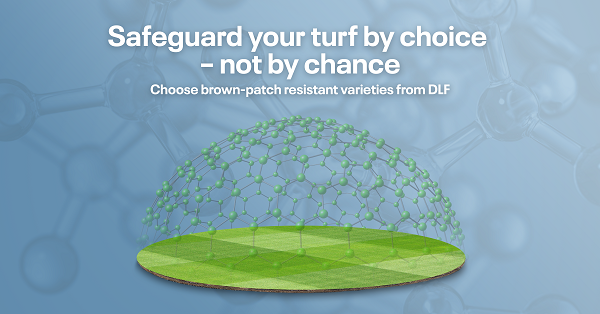Brown-patch resistant 4turf® doesn’t leave it to chances
20/02/2023

Climate change is putting pressure on turf areas, especially on summer renovations of pitches, which are now taking place in warmer and more humid weather – optimal conditions for the growth of the pathogenic fungus brown patch. Professional turf managers therefor need to choose disease-resistant turf varieties for their turf areas, that can safeguard their turf and give them a peace of mind. 4turf® varieties from DLF can give professional turf managers the peace of mind they are looking for, since they are more brown-patch resistant. The more disease-resistant the turf, the more effective and cost saving those summer renovations will be.
Football’s narrow window of opportunity for repairs
Top-class football takes place almost all year round. Apart from a brief break over the summer, the season is packed tight with matches. By season end, pitches are worn, tired, and in need of repair. These urgent stadium and training-ground renovations take place during the short match-free summer, often with the establishment of new turf.
Pitch renovation is a crucial time for grounds managers. They want their pitches renewed – to be green and healthy for players and fans to enjoy – but time is tight. There are no second chances during a summer renovation. Warmer and more humid summers create ideal conditions for brown patch which can damage the entire pitch. By choosing disease-resistant varieties, grounds managers increase their chances of achieving a beautiful, green and healthy pitch.
Varieties tested for resistance to brown patch
Brown patch is a turfgrass foliar disease caused by Rhizoctonia spp. The fungus can attack all cool-season turfgrasses, but is most devastating to Perennial ryegrass, Bentgrass and Tall fescue. There are many examples of damage it has caused during summer renovations of sports pitches. In the worst cases, the professional turf manager will lose all the turf on a newly established pitch, and must repeat the sowing. This inevitably leads to a postponement of the opening games of the season.
Future-proof your turf with brown-patch resistant varieties
To minimise the chance of losing an entire newly established turf area, professional turf managers should choose mixtures containing varieties with a high brown-patch resistance.
DLF has, through screening methods, tested a number of turf varieties and identified 4turf® varieties to be the most brown-patch resistant. Furthermore, some of our DLF diploid Perennial ryegrass varieties GILDARA, MONROE, ANISTON, ASPIRE, and CHLOE, has shown excellent brown-patch resistance as well.
Choose more sustainable turf
Choosing grasses with a higher disease-resistance is also a step towards more sustainable turf maintenance. These grasses reduce your need for fungicides and herbicides. They are less likely to be attacked by fungal diseases, which also leads to less weeds.
A reduction in pesticide consumption is a step towards the UN's sustainable development goal no. 15, which deals with the protection, restoration, and sustainable use of ecosystems. A reduction in pesticide use also helps to comply with the EU directive on sustainable use of pesticides (Directive 2009/128/EC).
Varieties that are resistant to brown patch require less maintenance. They cut maintenance costs because they’re more likely to establish well during a summer renovation, which limits the need for re-sowing or for pesticide applications. They also require less maintenance, which reduces the CO2 emission. This is a step towards fulfilling the UN sustainable development goal no.13 which is to take action to combat climate change.
Learn more about disease-resistant 4turf® varieties
To find out more about disease-resistant turfgrass and disease-resistant 4turf® varieties available in your market, speak to your DLF representative or learn more about brown patch on our website.
